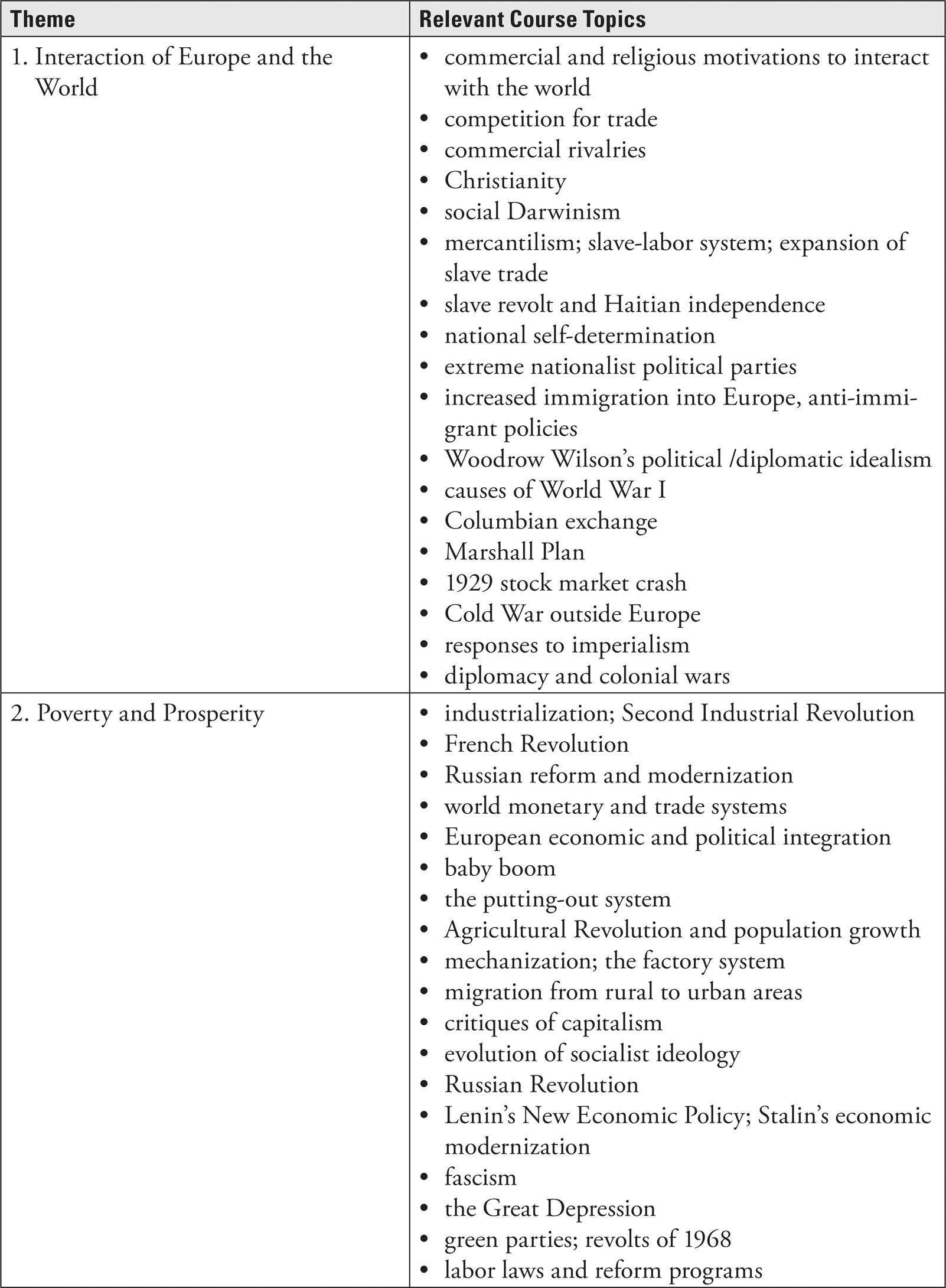Part III
About the AP European History Exam
THE STRUCTURE OF THE AP EUROPEAN HISTORY EXAM
The AP European History Exam, which was redesigned for the May 2018 administration of the test, is 3 hours and 15 minutes long and broken up into two sections, each of which consists of two parts. Your performance on these four parts, outlined in the table below, is compiled and weighted to find your overall exam score.
| Question Type (#) | Time | |
| Section I | Part A: Multiple Choice (55 questions) | 55 minutes |
| Part B: Short Answer (3 questions) | 40 minutes | |
| Section II | Part A: Document-Based Question (1 question) | 60 minutes (includes a reading period with a suggested time of 15 minutes) |
| Part B: Long Essay (1 question, chosen from a pair) | 40 minutes |
Here’s what to expect in each of these parts:
-
Multiple Choice: Questions will be grouped into sets of two to five and based on a primary or secondary source, including excerpts from historical documents or writings, images, graphs, maps, and so on. Each set of questions will be based on a different piece of source material. You’ll have 55 minutes to answer 55 multiple-choice questions. This section will test your ability to analyze and engage with the source materials while recalling what you already know about European history.
-
Short Answer: This section consists of three questions that will be based on a primary or secondary source. There will be two questions you must answer and then you can choose between two others. All questions will ask you to identify and analyze historical evidence. The time allotted for this section is 40 minutes, which means you’ll have a little over 13 minutes for each question. You must answer the first two questions and then you can choose between either question 3 or question 4.
-
Document-Based Question (DBQ): Here you’ll be presented with a variety of historical documents that are intended to show the complexity of a particular historical issue. You will need to develop a thesis that responds to the question prompt and to support that thesis with evidence from both the documents and your knowledge of European history. To earn the best score, you should incorporate outside knowledge and be able to relate the issues discussed in the documents to a larger theme, issue, or time period. The 60-minute time frame for this section includes a suggested 15-minute reading period so that you can familiarize yourself with the question and documents.
-
Long Essay: You’ll be given a choice of two essay options, and you must choose one. The long essay is similar to the DBQ in that you must develop a thesis and use historical evidence to support your thesis, but there will be not be any documents on which you must base your response. Instead, you will need to draw upon your own knowledge of topics you learned in your AP European History class. You’ll have 40 minutes to write this essay.
HOW THE AP EUROPEAN HISTORY EXAM IS SCORED
Each of the four parts is weighted differently to determine your overall score.
| Test Section | Percentage of Overall Score |
| Multiple Choice | 40% |
| Short Answer | 20% |
| DBQ | 25% |
| Long Essay | 15% |
As you can see, the writing portions of the exam count a little more heavily toward your total score (a combined total of 60 percent) than the multiple-choice section (40 percent). The DBQ and long essay are scored according to separate rubrics. You can earn a maximum of 6 points on the DBQ and 5 points on the long essay.
Here’s how those points are earned:


OVERVIEW OF CONTENT TOPICS
The AP European History course is broken down into four key time periods:
Period 1: c. 1450 to c. 1648
Period 2: c. 1648 to c. 1815
Period 3: c. 1815 to c. 1914
Period 4: c. 1914 to present
We’ve organized the chapters in this book to reflect this periodization.
In addition, the course focuses on five major themes: (1) interaction of Europe and the world, (2) poverty and prosperity, (3) objective knowledge and subjective visions, (4) states and other institutions of power, and (5) the individual and society. The goal of the course is to get you to think conceptually about European history and understand how these themes are manifested throughout history. The questions on the exam will also be rooted in these five themes, which, like the time periods listed above, will receive about equal coverage on the test. While there is no rigid set of topics that fall into each of these theme categories, the following table highlights some topics that will likely be addressed. (Please keep in mind that this list is not in chronological order, nor is it a comprehensive list. This is just a small sampling of the kinds of topics that fall under these thematic umbrellas. There are many, many more topics!)


Additionally, the AP European History course emphasizes key historical thinking skills, which will also be tested on the exam in how you grasp the source material presented throughout the test, as well as how demonstrate your ability to make historical connections in writing for the DBQ and long essay. The historical thinking skills you will develop in the course and be tested on are grouped into four main areas: (1) analyzing historical sources and evidence; (2) making historical connections; (3) chronological reasoning; and (4) creating and supporting a historical argument.
HOW AP EXAMS ARE USED
Different colleges use AP Exams in different ways, so it is important that you go to a particular college’s website to determine how it uses AP Exams. The three items below represent the main ways in which AP Exam scores can be used:
-
College Credit. Some colleges will give you college credit if you score well on an AP Exam. These credits count toward your graduation requirements, meaning that you can take fewer courses while in college. For those who pay for college per credit or course, rather than per semester or year, this could be quite a benefit, indeed.
-
Satisfy Requirements. Some colleges will allow you to “place out” of certain requirements if you do well on an AP Exam, even if they do not give you actual college credits. For example, you might not need to take an introductory-level course, or perhaps you might not need to take a class in a certain discipline at all.
-
Admissions Plus. Even if your AP Exam will not result in college credit or even allow you to place out of certain courses, most colleges will respect your decision to push yourself by taking an AP course or even an AP Exam outside of a course. A high score on an AP Exam shows mastery of more difficult content than is taught in many high school courses, and colleges may take that into account during the admissions process.
OTHER RESOURCES
There are many resources available to help you improve your score on the AP European History Exam, not the least of which are your teachers. If you are taking an AP class, you may be able to get extra attention from your teacher, such as obtaining feedback on your essays. If you are not in an AP course, reach out to a teacher who teaches European history and ask if the teacher will review your essays or otherwise help you with content.
Another wonderful resource is AP Students, the official site of the AP Exams. The scope of the information at this site is quite broad and includes the following items:
-
course description, which includes details on what content is covered and sample questions
-
essay prompts from previous years
-
AP European History Exam tips
The AP Students home page for the AP European History Exam can be found here: https://apstudent.collegeboard.org/apcourse/ap-european-history.
Finally, The Princeton Review offers tutoring for the AP European History Exam. Our expert instructors can help you refine your strategic approach and add to your content knowledge. For more information, call 1-800-2REVIEW.
DESIGNING YOUR STUDY PLAN
As part of the Introduction, you identified some areas of potential improvement. Let’s now delve further into your performance on Practice Test 1, with the goal of developing a study plan appropriate to your needs and time commitment.
Read the answers and explanations associated with the multiple-choice questions (starting at this page). After you have done so, think about the following items:
-
Review the Overview of Content Topics and decide which areas you feel confident about and which you need to further review.
-
How many days/weeks/months away is your AP European History Exam?
-
What time of day is your best, most focused study time?
-
How much time per day/week/month will you devote to preparing for your AP European History Exam?
-
When will you do this preparation? (Be as specific as possible: Mondays and Wednesdays from 3:00 to 4:00 P.M., for example.)
-
Based on the answers above, will you focus on strategy (Part IV), content (Part V), or both?
-
What are your overall goals in using this book?


